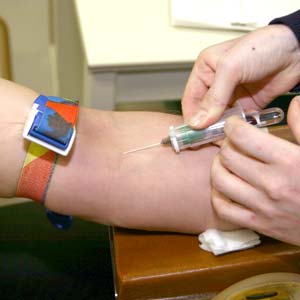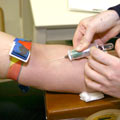Description of the test
Diabetes causes uncontrolled high blood glucose (sugar). Monitoring blood glucose regularly is an important step to managing blood sugar.
Another test used to assess blood sugar control is the hemoglobin A1C test. This test measures how much glycosylated hemoglobin (also called hemoglobin A1C) is in the blood.
Hemoglobin A1C is formed when blood sugar sticks to hemoglobin of red blood cells. As blood sugar levels rise, so do levels of hemoglobin A1C. Since red blood cells live for about 3 months, the hemoglobin A1C level indicates how well blood sugar has been controlled over the last 3 months.
How often should the test be performed?
Hemoglobin A1C should be measured every 3 to 6 months if you have diabetes. If your blood glucose is well managed, it is usually measured every 6 months. However, if your blood sugar is high or your diabetes medication regimen is changed, your doctor may want to measure the hemoglobin A1C more frequently (every 3 months) until your blood sugar returns to an acceptable range.
Why is this test performed?
The hemoglobin A1C is an accurate way to measure how well your diabetes treatment plan is working. It provides information about the average glucose level in your blood over the last 3 months, and it does not show daily fluctuations. When blood sugars are consistently high over time, the hemoglobin A1C will also be high.
When hemoglobin A1C is high, changes to your medication or lifestyle (exercise or diet) are needed.
A hemoglobin A1C may also be done to diagnose diabetes or prediabetes.
Are there any risks and precautions?
Although the hemoglobin A1C is considered safe, it does have some risk of side effects or complications. Though rare, the side effects or complications may include:
- infection (if the area is not properly sterilized before the sample is taken)
- excess bleeding from the puncture
- bruising and swelling where the needle was inserted
- lightheadedness or fainting
People with bleeding disorders or anyone taking medication that reduces the ability of the blood to clot (e.g., warfarin, ASA, or other anticoagulants) should tell the technician before the samples of blood are taken. These conditions and medications may require special attention at the time of testing.
What happens during the test?
To measure hemoglobin A1C, a blood sample needs to be obtained. Blood is collected into one or more small vials labelled with your information.
The technician should wear fresh latex gloves and use a new, single-use needle for each procedure.
- To draw the sample, a technician or nurse wraps a wide elastic band around your upper arm to help locate the vein.
- Once the vein is located, usually on the inside of your elbow, the area is disinfected using alcohol swabs.
- The technician inserts a needle into a vein and pushes a vial onto the needle to collect the blood.
- The elastic band is removed and after the blood is collected, the needle is removed and discarded.
- You will have to hold a small piece of cotton over the area until bleeding stops. A small bandage will be applied to hold the cotton in place.
The test is almost painless for most people, although you may feel a slight pinch when the needle is inserted. The vials of blood are then sent to a laboratory for analysis.
How should I prepare for this test?
You do not need to fast or change your diet for this test.
Tell your doctor or prescriber about all prescription, over-the-counter (non-prescription), and herbal medications that you are taking. Also tell them about any medication allergies and medical conditions that you may have.
Ask your doctor or pharmacist whether you need to stop taking any of your medications before the test.
What can I expect after the test?
Slight tenderness may occur where the needle was inserted.
Results
Hemoglobin A1C is recorded as a percentage. In general, for a person with diabetes, the target hemoglobin A1C is 7% or less. Levels 7% or less may help reduce the risk of complications associated with diabetes such as kidney disease, eye problems, nerve damage, and need for amputation.
Your doctor may recommend a slightly different target depending on your age and other conditions.
Ask your doctor when your test results should be available. Talk to your doctor about your results so you understand their significance.
All material copyright MediResource Inc. 1996 – 2024. Terms and conditions of use. The contents herein are for informational purposes only. Always seek the advice of your physician or other qualified health provider with any questions you may have regarding a medical condition. Source: www.medbroadcast.com/procedure/getprocedure/Hemoglobin-A1C


